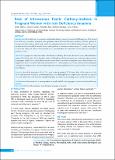Please use this identifier to cite or link to this item:
https://hdl.handle.net/20.500.14356/1654| Title: | Role of Intravenous Ferric Carboxy-maltose in Pregnant Women with Iron Deficiency Anaemia |
| Authors: | Mishra, Vineet Gandhi, Khusaili Roy, Priyankur Hokabaj, Shaheen Shah, Kunur N |
| Citation: | MishraV., GandhiK., RoyP., HokabajS., & ShahK. N. (2017). Role of Intravenous Ferric Carboxy-maltose in Pregnant Women with Iron Deficiency Anaemia. Journal of Nepal Health Research Council, 15(2), 96-99. https://doi.org/10.33314/jnhrc.v15i2.1047 |
| Issue Date: | 2017 |
| Publisher: | Nepal Health Research Council |
| Keywords: | Ferric carboxymaltose Iron Deficiency anaemia Pregnancy |
| Series/Report no.: | May-Aug, 2017;1047 |
| Abstract: | Abstract Background: Iron deficiency is a common nutritional deficiency amongst women of childbearing age. Peri-partum iron deficiency anaemia is associated with significant maternal, foetal and infant morbidity. Current options for treatment include oral iron, which can be ineffective and poorly tolerated, and red blood cell transfusions, which carry an inherent risk and should be avoided. Ferric carboxymaltose is a modern treatment option. The study was designed to assess the safety and efficacy of intravenous ferric carboxymaltose for correction of iron deficiency anaemia in pregnant women. Methods: A prospective study was conducted at Institute of Kidney Disease and Research Centre, Ahmedabad from January 2014 to December 2016. Antenatal women (108) with iron deficiency anaemia were the study subjects. Socio-demographic profile was recorded and anaemia was assessed based on recent haemoglobin reports. Iron deficiency was diagnosed on basis of serum ferritin value. Intravenous ferric carboxymaltose as per total correction dose (maximum 1500mg) was administered to all women; the improvement in haemoglobin levels were assessed after 3 weeks of total dose infusion. Results: Most of the women(n= 45, 41.7%), were in the age group of 27-30 years. Most of the women (n = 64, 59.3%) had moderate anaemia as per WHO guidelines. Mean haemoglobin levels significantly increased over a period of 3 weeks after Ferric carboxymaltose administrationand no serious life threatening adverse events were observed. Conclusions: Intravenous ferric carboxymaltose was safe and effective in pregnent women with iron deficiency anaemia. Keywords: Ferric carboxymaltose; iron; deficiency anaemia; pregnancy. |
| Description: | Original Article |
| URI: | http://103.69.126.140:8080/handle/20.500.14356/1654 |
| ISSN: | Print ISSN: 1727-5482; Online ISSN: 1999-6217 |
| Appears in Collections: | Vol 5 No 2 Issue 36 May-Aug 2017 |
Files in This Item:
| File | Description | Size | Format | |
|---|---|---|---|---|
| 1047-Article Text-2318-2-10-20170910.pdf | Fulltext Download | 206.84 kB | Adobe PDF |  View/Open |
Items in DSpace are protected by copyright, with all rights reserved, unless otherwise indicated.
